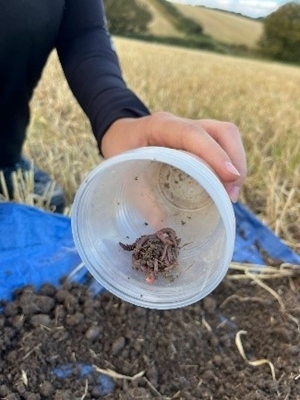By Georgia Gargett, Scottish Lowlands Placement Student
 The Scottish Lowlands team had a busy start to the autumn, with the past couple weeks filled with fieldwork, travel and more fieldwork.
The Scottish Lowlands team had a busy start to the autumn, with the past couple weeks filled with fieldwork, travel and more fieldwork.
September kicked off with Visual Evaluation of Soil Structure (VESS) assessments and worm counts. We have visited multiple farms already with more sites to be visited throughout the autumn period.
For each VESS sample, an approximately 30cm deep hole must be dug. However, when doing this in compacted, crop-covered and rocky soil, this can result in a very labour-intensive job where ‘digging’ becomes ‘jumping on the spade’. The soil from the hole should be placed as carefully as possible onto a tarp. This is in order to identify any ‘limiting layers’ where the soil quality is worse. However, much of the soil samples did not tend to hold shape at all and would instead crumble into a pile, making the identification of limiting layers a rather more difficult process.


Scoring the soil was truly a ‘hands-on’ or more specifically ‘nose-in’ process, requiring close inspection, feeling and indeed smelling the samples. We rated the soil from 1 (good) to 5 (poor), based on pore number, aggregate shape, texture and odour. Interestingly, scores varied widely between fields and even within different areas of the same field, with some ranging from 1 to 5 in a single location.
Alongside VESS assessments, we also conducted worm counts. For this, we spent five minutes of sifting through the collected soil samples to try to collect worms. The resulting bundle of worms were categorised as either Juvenile or Adult; adults were distinguished not through size but through the presence of a ‘saddle’, which is used during the mating process. Adults were further identified as being either anecic, epigenic or endogenic, all which have different roles for soil health.
Also completed were the annual invertebrate monitoring at Balgonie Estates, a project the GWCT has been part of for several years. The traps consist of buried cups filled with water and dish soap, covered with mesh to collect unsuspecting insects. These samples, which we’ll identify later, will be used to determine the distance invertebrates will travel away from the biodiversity mix, giving us insights into how biodiversity mixes can be used in integrated pest management plans.
After a week of being outside in the fresh air, we embarked on a long eight-hour drive from Scotland down to induction training in Fordingbridge, Hampshire. This session was a great opportunity to meet other teams from across the organisation and learn about the diverse research they’re conducting. Hearing about the day-to-day operations of the Trust certainly made the trip both interesting and worthwhile, despite the long journey. The highlight of the induction was an exciting 4x4 off-road training course that provided important skills such as driving through deep water, navigating steep slopes and how to reverse down a hill without losing our dignity (or the vehicle).

All in all, here’s hoping these first adventures are just the start of an interesting, educational, and hopefully less muddy year at the Game & Wildlife Conservation Trust!